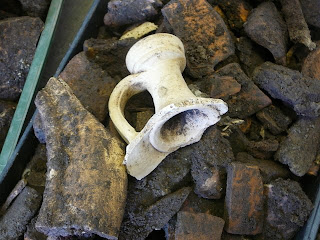



The community dig is over, Open day, post-dig party and all. It's been good. We've been very lucky, mostly. Some awful weather, some very good, but my hat keeps off rain and sun. A good team of amateurs, trained and led by excellent professionals. A wonderful site, with the Roman features two feet down so that the digger did the hard work to get there.
I couldn't spend so much time there as I have at previous digs, but I have tried to get there on a Friday morning at 11.00 for the weekly update, mostly conducted by the magnificent Hal Dalwood, telling the background history as well as interpreting the mysterious shapes in the earth colours for us. Last week he told us the latest interpretation of our Roman buildings: a street running close to the railway viaduct, with a large house / factory, tall enough for two storeys, walls of earth or stone, or possibly bricks topped by wood. Then at least three smaller houses towards the river. This is the end of the trench so far. We have ovens inside the houses, one an earthenware bread oven which we have most of, and one on a beaten clay floor, with indications that it was used at high temperatures so was used for metal alloys or glass. There are stone features elsewhere on the site, which cannot be interpreted yet.
Although the amateurs have left the site, it's not all over. Now the professionals, trained to work safely at speed and in less favourable weather, can get down to the lower, older layers of Roman history. You can still visit the site as long as it is safe to do so, and the exhibition is continuing, but there will only be an archaeologist free to talk to you on Friday at 11.00. I'll continue to go when I can, and report back.
Hope to see you there!











































